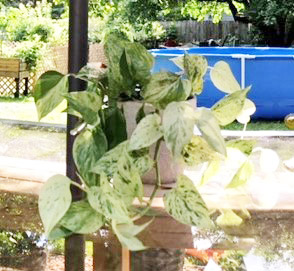Talking Plants
Jillian Patrie | University of Minnesota Yard and Garden Extension
Houseplant enthusiasts have had plant collections stuffed into their homes for the last 7-8 months and now it is time to get them outdoors. When transitioning houseplants from indoors to outdoors, there are a few things to consider making the process go smoothly.
Leaving houseplants outdoors permanently can occur when nighttime temperatures are constantly around 60 degrees. In the meantime, getting them outdoors when the daytime temperatures are warm and bringing them inside at night is best. Just like seedlings, houseplants need to be acclimated to their new environment. Choose a space that is out of the wind and direct sunlight in the beginning. If houseplants are exposed to direct sunlight immediately, the leaves will often burn, this is true for succulents too. The leaves need time to adjust to the sun, just like us!
Sometimes plants can become elongated because of limited sunlight throughout the winter months. This means they have been stretching to reach the sunlight in windows, which can cause the stems to become weak. Rotate houseplants in their locations during the winter months to even out the light distribution. When it is time to put them outside for the summer, make sure they start out in a protected location. Houseplants need to regain their stem strength before being moved to their usual summer spot.
Just like outdoor containers, houseplant pots should have drainage. If your houseplant does not have a drainage hole, consider transferring it to a pot that does for the summer. Be mindful of the location of houseplants outside. Many succulents and cacti prefer the sun, enjoying locations with the most direct sun possible. Others, like ferns, philodendrons, pothos, snake plants and other leafy houseplants grow as understory vegetation in the wild and prefer a spot with half sun to full shade.
Putting houseplants outside for the summer can help eliminate pesky insects that are hard to control inside too. Spider mites are one of the hardest insect pests to control in an indoor environment. Summer weather like rain and humidity can keep them at bay. Natural predators are abundant outside too, many beneficial insects can help control common houseplant pests like aphids.
When adding new houseplants to your collection or bringing them inside after being outside, take a few precautions to ensure plants are not homes for unwanted insects. It is a good idea to quarantine new plant additions before placing them near other plants. Monitor them for a couple of weeks to make sure they do not have any insect pests that can spread to other plants. When bringing plants inside for the winter, treat them with an all-purpose insecticide a few weeks before they need to come inside.
For houseplants that stay inside all year around, there are a couple tips and tricks for common houseplant pests. Fungus gnats are one of the most common pests for houseplant owners. Fungus gnats are sometimes confused with fruit flies, they are not the same. Fungus gnats live in moist soil, avoid overwatering, and only water plants when necessary. If you have fungus gnats, don’t worry, they generally do not harm plants. Add yellow sticky traps to the plant container to catch the adults. If you have mealy bugs (white and fuzzy, usually in leaf folds and other hard to reach areas), dab them with rubbing alcohol on a Q-Tip. Aphids and/or spider mites will need to be treated with a contact insecticide, as their populations can explode quickly.
To learn more about healthy houseplants visit extension.umn.edu. If you have questions about this article or need help with houseplants, contact your Local Clay County Extension Educator, Jill Patrie at patri350@umn.edu, or by phone at 218-299-7338.



